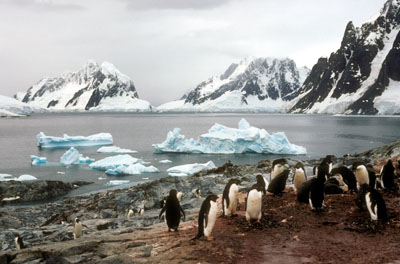Photography in polar environments, typically on the continent of Antarctica or within the Arctic Circle, presents a number of unique challenges. The first and most obvious problem is the low temperature. The temperatures experienced in Antarctica are generally much lower than those found in the Arctic. Remember that the Arctic is an ocean surrounded by land. Antarctica is a continent surrounded by ocean, and its interior is extremely cold. Tourists visiting the Antarctic Peninsula are more likely to be faced with wet conditions than seriously low temperatures. In summer, daytime temperatures may be only a few degrees below freezing. However, precipitation is significant and may be such that a waterproof camera housing is required.

In the interior of Antarctica, the summer temperature is likely to be around -20oC, but in the winter it may fall to -80oC. At these temperatures, batteries of most types have a short working life. At -20oC they may last for 15 minutes, but at -80oC they die almost as soon as they are taken outside. All-electronic cameras which rely upon battery power are therefore likely to be unreliable unless they are equipped with an external power supply kept warm by being stored close to the body of the photographer. Even then they may fail because lubricants have solidified. Overall it may be wiser to use a reliable manual camera such as a Nikon FM2 suitably prepared by Nikon for the polar environment. Lubricants thicken at low temperatures and some solidify at -80oC, so the application of special low-temperature lubricants may be necessary. It is also worth remembering that film becomes brittle at low temperatures and may crack if wound or rewound too quickly. Allow several seconds for each frame to be rewound. Static discharge between film and camera may also occur if film is rewound too rapidly. This may cause random flashes of light across the frames of a film.
Condensation may also be a problem with cameras which rely upon electronics. Even if they continue to work when outside, they may fill with condensation when they are brought inside to warm up. The first sign of the problem is usually revealed by lenses fogging over. A solution is to encase a cold camera in an insulating bag and hence slow down the rate at which it rises in temperature.
Another problem caused by low temperatures is that human flesh freezes on to exposed metal surfaces. This can be very painful and may also result in significant damage to the photographer's face and hands. Metal surfaces of cameras and tripods should therefore be covered in insulating tape to reduce the rate at which body heat is transferred to exposed surfaces.
When working in remote areas such as the polar regions is always wise to carry plentiful supplies of consumables such as batteries, film and memory cards - and even spare cameras. The polar regions are very photogenic so be prepared to take lots of pictures. Remember that the nearest photographic store may be several thousand miles distant, and repair workshops are non-existent.
Exposures are sometimes a problem in an all-white world because automatic metering systems assume that the world is 18% grey. However, in the polar regions that is often not the case. It is therefore necessary to meter from a grey card, or for the highlights, so that sufficient detail is retained in all-white objects such as icebergs.